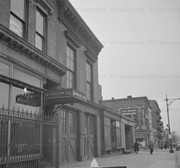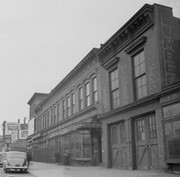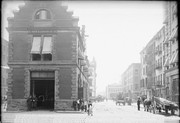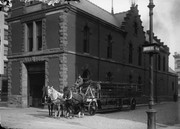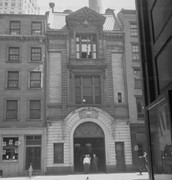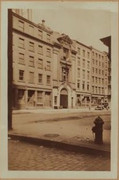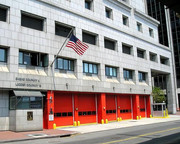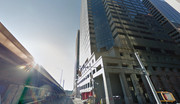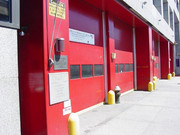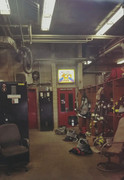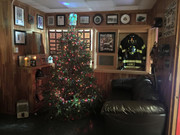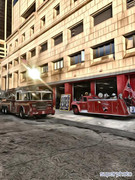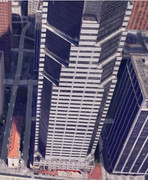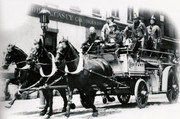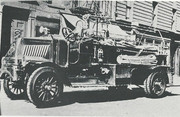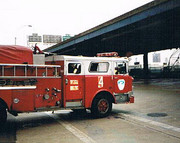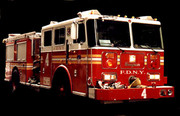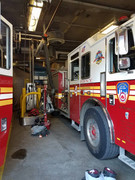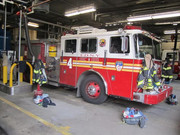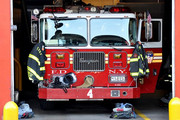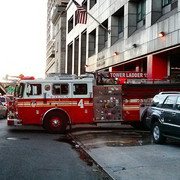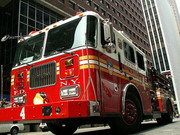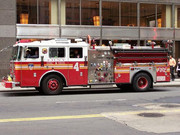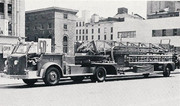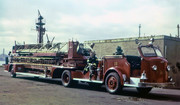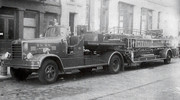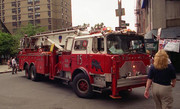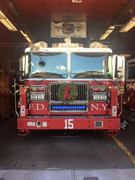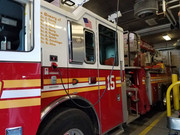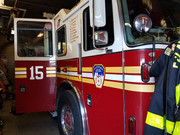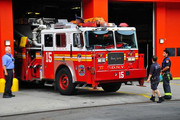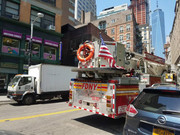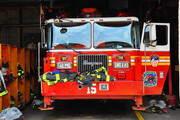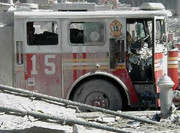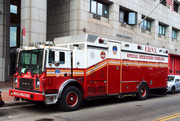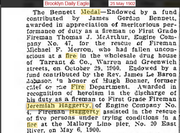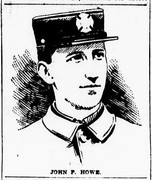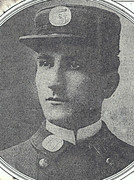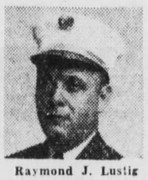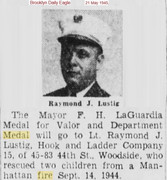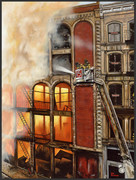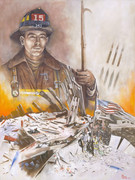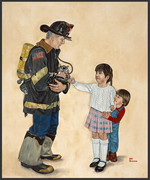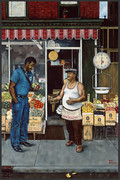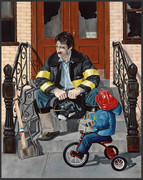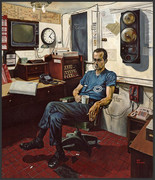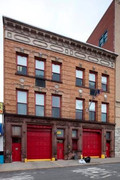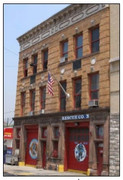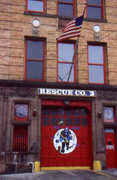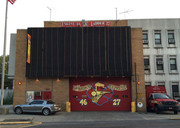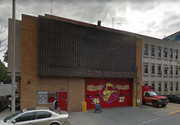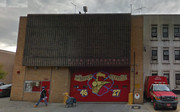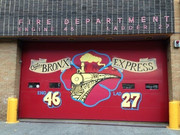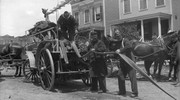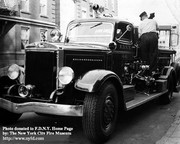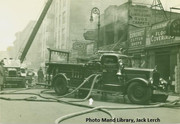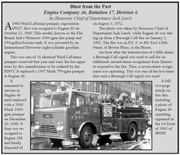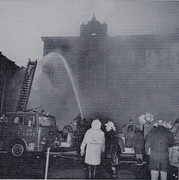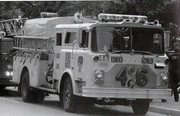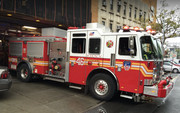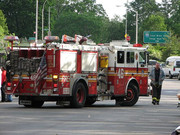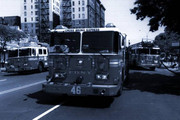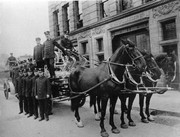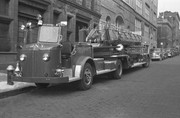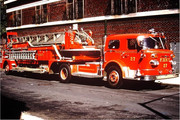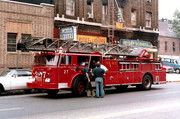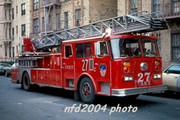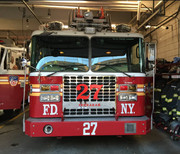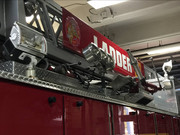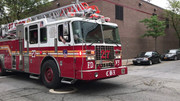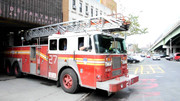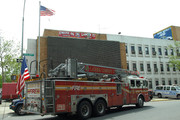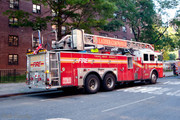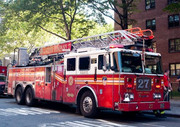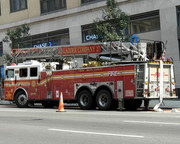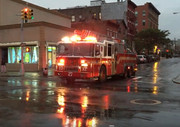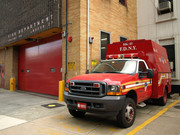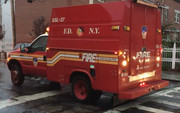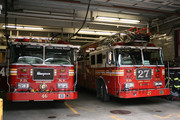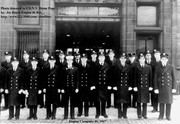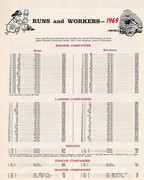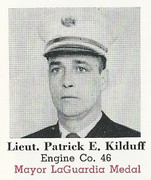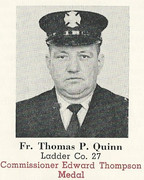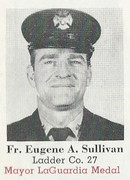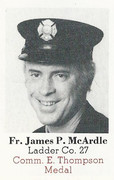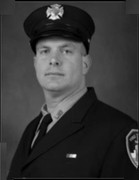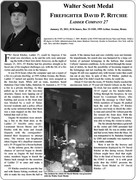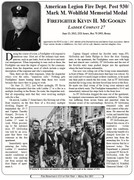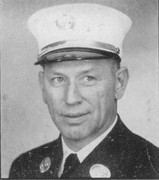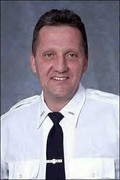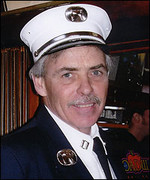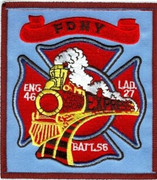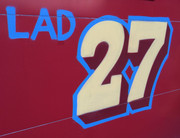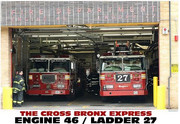Engine 4/Ladder 15 (continued)
Engine 4/Ladder 15 LODDs:
FIREFIGHTER THOMAS IRWIN ENGINE 4 DECEMBER 2, 1865

The fire was in a warehouse used to store cargo that was to be shipped out of or into the harbor. Engine 4 was operating a hoseline in front of the building. Inside, multiple bales of cotton were being stored, they began soaking up the water being used on the fire. Some of the bails expanded to the point of knocking down the front wall of the building. FF Irvin was struck by the debris and pounced dead at the scene.
FIREFIGHTER DOMINICK SICOT ENGINE 4 DECEMBER 14, 1865


Fireman Dominick Sicot of Engine 4 fell from the roof of 16 Water Street. He was with his company on the roof using a hose, throwing water into the fire building. He fell in the rear of the building and was taken to City Hospital where he died a month later. Born in Ireland and thirty-one years of age, Sicot was a member of the fire department for only two months when he died. (From "The Last Alarm")
While operating on November 9, 1865 in the 7th District at 14 Water Street, Engine 4 had stretched a line to the roof of the adjoining building at 16 Water Street. While operating on the roof, FF Sicot fell off the rear of the building. He was taken to City Hospital where he succumbed to his injuries.
FIREFIGHTER EDWARD BURKE ENGINE 4 JUNE 29, 1872

Manhattan Box 36 18-20 Liberty Street
On June 22, 1872, Engine 4 had just finished extinguishing the main body of fire and overhauling the building had just begun. Chemicals which were in the building reacted to the heat and exploded. 21 members of Engine 4 & 6, Ladders 1, 8 & 10 were burned in the explosion. Fireman Burke Succumbed to his injuries on June 29, 1872.
FIREFIGHTER DANIEL F. MULLEN ENGINE 4 May 4, 1900
While ascending a ladder with hose, the hose was charged before FF Mullin could maintain a secure grip on the ladder. He was thrown to the pavement below fracturing his skull.
FIREFIGHTER JOHN J. McCONNELL ENGINE 4 February 4, 1908
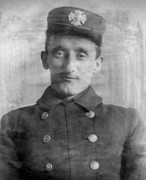
Firemen Thomas P. Eglinton, of Ladder 10 and John J. McConnell of Engine 4, were killed when the second and third floors of 43 Worth Street collapsed, carrying fourteen firemen down with them in this three-alarm fire. Engine 4 was operating on the third floor and Ladder 10 was on the second floor. The fire had started around 4:00 p.m. on the third floor. A heavy safe located in the front part of the third floor went crashing into the basement around 5:40 p.m. Both firemen killed were not dug out and removed until after midnight. McConnell reported to the fire from his meal break. He returned to the firehouse to find his company out and then went to the fire. He removed his helmet and coat from the hose wagon and followed the hose from his engine up to the floor where his company was working. As he entered the third floor, the floor broke under the weight the heavy safe. McConnell?s body was found crushed and burned. He was thirty-three years old, married and lived at 313 East 43rd Street. Eglinton's body was found later and was not crushed or burned. He landed in a lean-to collapse in the rear of the building. He tried to escape but the windows had bars on them and he was trapped. The fire was fought for some thirty hours in below-zero weather. When his body was found he was frozen to death. Eglinton was married and his wife was expecting their first child soon. He lived at 380 18th Street, Brooklyn. (From "The Last Alarm")
FIREFIGHTER CALIXTO ANAYA JR ENGINE 4 September 11, 2001
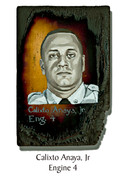


Attack on World Trade Center
http://www.firefightermemorial.net/Html/Firefighter_Calixto_Anaya.html
BATTALION CHIEF JOSEPH FARRELLY ENGINE 4 September 11, 2001
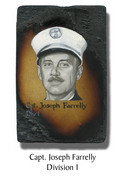

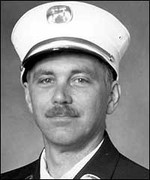
Attack on World Trade Center
http://www.legacy.com/Sept11/Story.aspx?PersonID=145290
https://www.silive.com/september-11/index.ssf/2010/09/joseph_farrelly_47_firefightin.html
FIREFIGHTER JAMES RICHES ENGINE 4 September 11, 2001
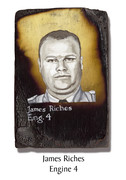
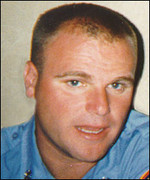
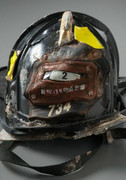
Attack on World Trade Center
https://www.firerescue1.com/terrorism-wmd-response/articles/1120424-Firefighter-Jimmy-Riches-A-smiling-face-that-we-miss-so-much/
https://www.firehero.org/fallen-firefighter/jimmy-riches/
FIREFIGHTER THOMAS SCHOALES ENGINE 4 September 11, 2001
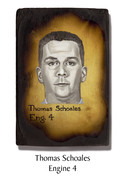
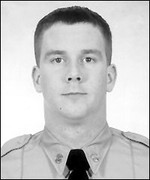

Attack on World Trade Center
https://www.firehero.org/fallen-firefighter/thomas-gerard-schoales/
https://nypost.com/2002/01/13/golden-boy-fireman-found-in-wtc-rubble/
FIREFIGHTER PAUL TEGTMEIER ENGINE 4 September 11, 2001
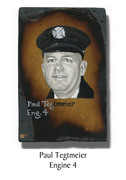
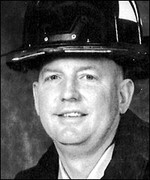
Attack on World Trade Center
https://www.firehero.org/fallen-firefighter/paul-a-tegtmeier/
https://www.poughkeepsiejournal.com/story/news/2017/02/10/dream-comes-true-son-fallen-firefighter-joins-fdny/97706406/
FIREFIGHTER DENNIS MCGEE LADDER 15 JANUARY 20, 1886
Fireman Dennis McGee of Ladder 15 fell from the ladder truck as he was moving from the side step to the side ladder [on January 9, 1886]. Ladder 15 was in Coenties Slip between Front and South Streets at the time. When he fell, the heavy apparatus?s rear wheel passed over him. It inflected a severe and deep wound on the inside of the leg above the knee joint. He was removed to Chambers Street Hospital and died at 6:59 p.m. from blood poisoning caused by the injuries. (From "The Last Alarm")
Manhattan Box 039 Coenties Slip & Front St
On January 12, 1886, While responding to Box 039 for a reported fire, FF McGee slipped from the step on the rig and fell to the street. The off Hind Wheel (Rear Tiller Wheel) ran over FF McGee's left leg. FF McGee was taken to Chamber Street Hospital. He died on January 20th from Blood Poisoning.
FIREFIGHTER HENRY J. HOEHN LADDER 15 February 27, 1930

Henry Hoehn, a fireman attached to Ladder 15, fell from the fourth floor elevator shaft to the sub-basement of the International Telegraph Building at 67 to 81 Broad Street. This was the second fire in this building that night. Fireman Hoehn was on the fourth floor looking up the elevator shaft to the seventh floor, where the fire was, lost his balance and fell to the second sub-basement. He suffered a fractured skull and spine. He was taken to the Broad Street Hospital where died several hours later. He was thirty-five years old and a member of the Department for eleven years. (From "The Last Alarm")
FIREFIGHTER FRED L. CUMMING LADDER 15 May 5, 1955
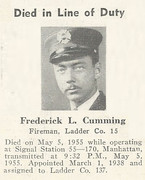
Fireman Frederick L. Cumming of Ladder 15 was overcome by smoke at this five-alarm fire while on the tip of the aerial ladder. He was brought down and rushed to a hospital but died in the ambulance. The fire was in a leather goods warehouse. He was married with three children. The forty-three year old fireman had been with the Department since March 1, 1938. (From "The Last Alarm)
FIREFIGHTER RICHARD ALLEN LADDER 15 September 11, 2001
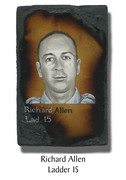
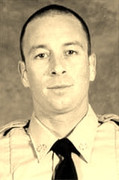

Attack on World Trade Center
http://www.legacy.com/sept11/Story.aspx?PersonID=126842&location=2
https://www.firehero.org/fallen-firefighter/richard-d-allen/
FIREFIGHTER ARTHUR BARRY LADDER 15 September 11, 2001
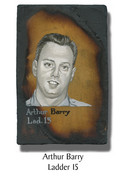
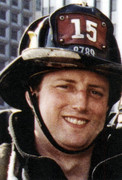
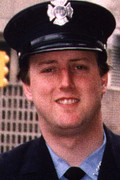
Attack on World Trade Center
https://www.firehero.org/fallen-firefighter/arthur-t-barry/
https://911alwaysremember.wordpress.com/2018/07/26/271-arthur-t-barry-wtc-124-firefighter-north-tower/
FIREFIGHTER THOMAS W. KELLY LADDER 15 September 11, 2001
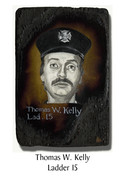
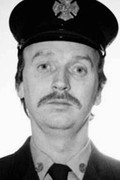
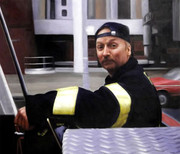
Attack on World Trade Center
https://www.silive.com/september-11/index.ssf/2010/09/thomas_kelly_51_a_firefighter.html
http://www.legacy.com/sept11/story.aspx?personid=146392
FIREFIGHTER SCOTT KOPYTKO LADDER 15 September 11, 2001
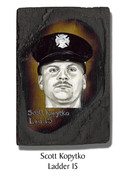


Attack on World Trade Center
https://www.firehero.org/fallen-firefighter/scott-michael-kopytko/
http://www.nydailynews.com/archives/news/wtc-trader-died-fireman-article-1.926181
FIREFIGHTER SCOTT LARSEN LADDER 15 September 11, 2001
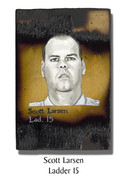
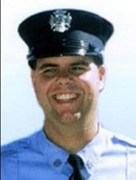
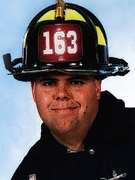
Attack on World Trade Center
http://www.legacy.com/Sept11/Story.aspx?PersonID=151830&location=2
http://www.qchron.com/editions/central/mourners-share-laughter-and-tears-as-firefighter-is-eulogized/article_ddc4c70d-8d56-57be-a442-c78deee4c6c4.html
LIEUTENANT JOSEPH LEAVEY LADDER 15 September 11, 2001
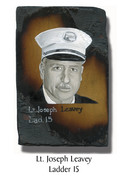
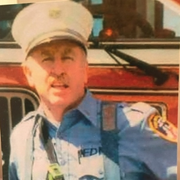
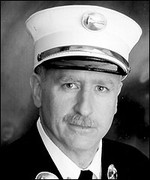
Attack on World Trade Center
http://www.legacy.com/sept11/story.aspx?personid=131684
https://www.firehero.org/fallen-firefighter/joseph-g-leavey/
http://ltjosephgleaveyfoundation.com/about/
FIREFIGHTER DOUGLAS OELSCHLAGER LADDER 15 September 11, 2001
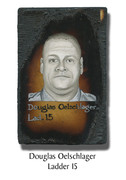
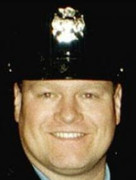

Attack on World Trade Center
https://www.cbsnews.com/news/portrait-of-a-hero/
http://betterangels911.com/firefighter-douglas-oelschlager/
FIREFIGHTER ERIC OLSEN LADDER 15 September 11, 2001
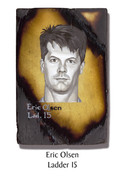

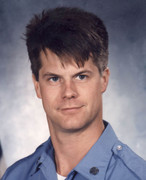
Attack on World Trade Center
https://www.silive.com/september-11/index.ssf/2010/09/eric_olsen_41_firefighter_love.html
http://www.legacy.com/sept11/story.aspx?personid=151770
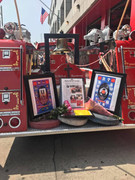
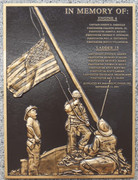
RIP. Never forget.

